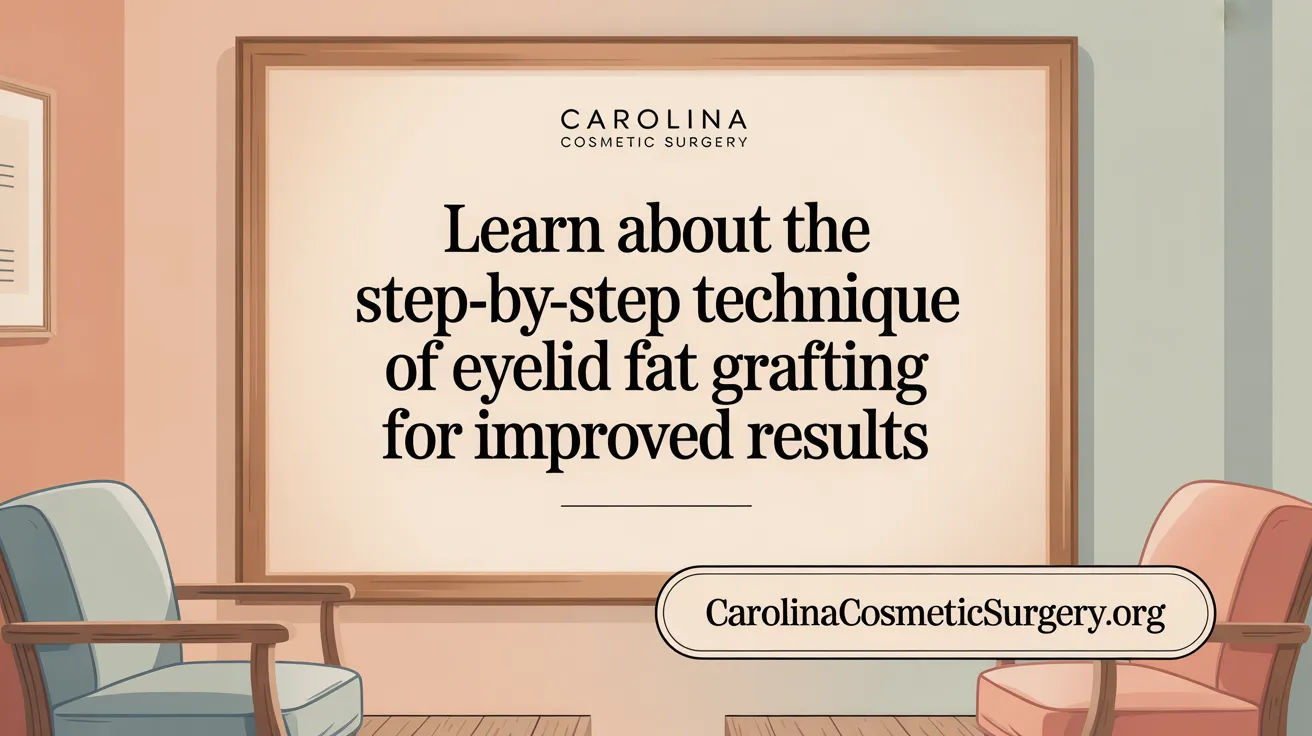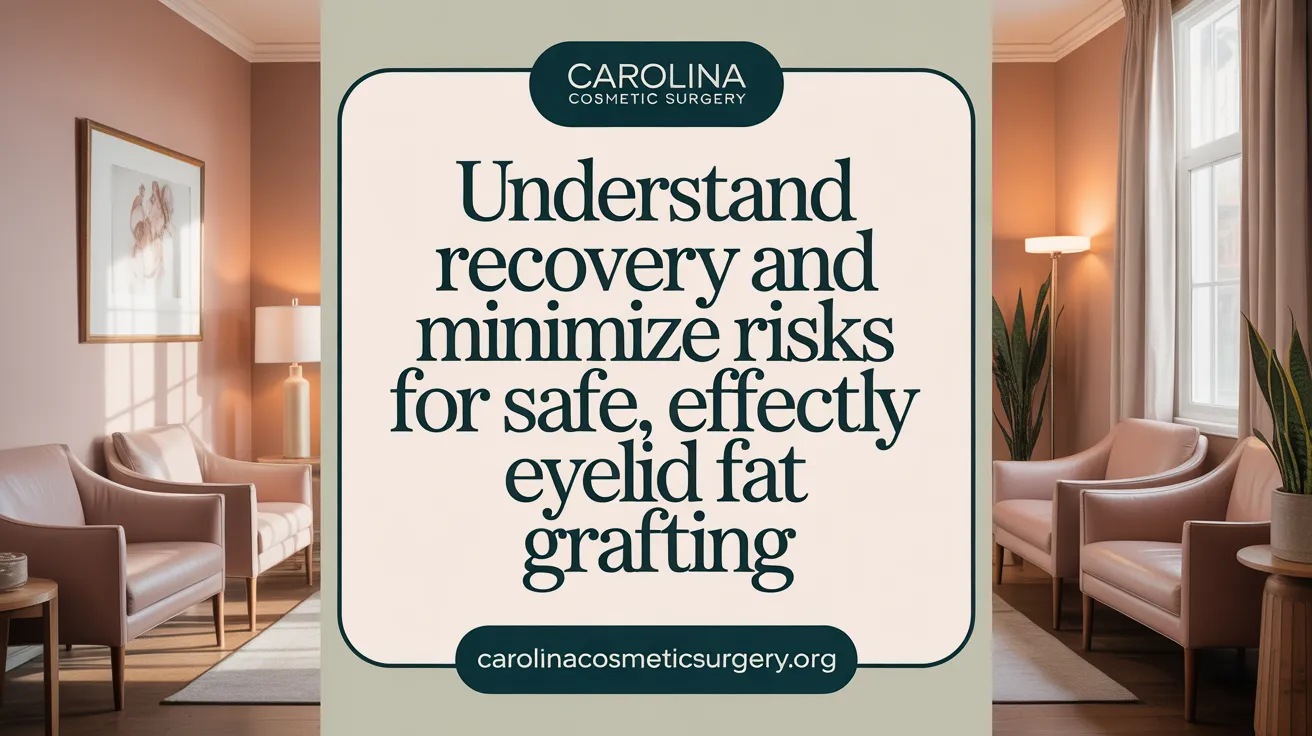Understanding Fat Grafting for Eyelid Volume Restoration
Fat grafting has emerged as a transformative technique in eyelid rejuvenation, leveraging the patient's own fat to restore youthful fullness around the eyes. Unlike synthetic fillers, this natural method rebuilds volume lost due to aging, stress, or genetics, offering both aesthetic and regenerative benefits. This article explores the comprehensive role of fat grafting in eyelid procedures, examining its process, benefits, risks, and integration with other facial rejuvenation strategies.
<!-- VIDEO:eyJsaW5rIjoiaHR0cHM6Ly93d3cueW91dHViZS5jb20vd2F0Y2g/dj1ySS1hcnc5Z3U3QSIsImltYWdlVXJsIjoiZGF0YTppbWFnZS9qcGVnO2Jhc2U2NCwvOWovNEFBUVNrWkpSZ0FCQVFBQUFRQUJBQUQvMndDRUFBa0dCd2dIQmdrSUJ3Z0tDZ2tMRFJZUERRd01EUnNVRlJBV0lCMGlJaUFkSHg4a0tEUXNKQ1l4Sng4ZkxUMHRNVFUzT2pvNkl5cy9SRDg0UXpRNU9qY0JDZ29LRFF3TkdnOFBHamNsSHlVM056YzNOemMzTnpjM056YzNOemMzTnpjM056YzNOemMzTnpjM056YzNOemMzTnpjM056YzNOemMzTnpjM056YzNOLy9BQUJFSUFGTUFsQU1CSWdBQ0VRRURFUUgveEFBYkFBQUNBd0VCQVFBQUFBQUFBQUFBQUFBRUJRQURCZ0lCQi8vRUFETVFBQUlCQXdNQ0JBVUNCZ01CQUFBQUFBRUNBd0FFRVFVU0lURkJFeUpSWVFZeWNZR1JGS0VqTTBKU3dmQWtjckVWLzhRQUd3RUFBUVVCQVFBQUFBQUFBQUFBQUFBQUFnQUJBd1VHQkFmL3hBQWxFUUFDQWdFRUFnSUNBd0FBQUFBQUFBQUFBUUlSQXdRU0lURUZRUk5STWtJaU0ySC8yZ0FNQXdFQUFoRURFUUEvQU1Yb3VudHErcVIyb1lvaDgwamorbFIxKzlmVzlOdDdLd3RZN2UwalNLTlJnQWRXOXllNTk2K1pmQnJtUFVKR0hWNDhEODF1VEtRbVJrR292SVpKUEp0ZlIyZU53eFdMZDdHTjYwZkt0elFzTjRFYlo0bVIyejFGS0xtN2JMWk9CU08rdlhSMVpXUEI1cXNhTGFNZlJyN3p4SlR1R0hIb0RVdDdWSlJrRElyT1crclNDTWVhbm1oWHJ6U2xXSGxwMEZKT3VCc2xnQU1ZN1ZGMDhsdWNDbUVZeW96WHVDZnBUc2d0Z290WWxIVEpxdVdOY1l4UnBIbHpRMHE1elVjb2lRbnZMYU9RRU9nSTk2eTE3cGx4cDh6WE9uRThjbVBPQWZwVzFtVVVET29aS1VKeXh1NGp6aEhKSGJMbEdmMDdWTFhWUTBYOG04VDU0bjRQMnF5U05rSlVqQkZLdml2UjJjQzlzeVk3bVBrTWh3VFZPbGZGS3lJbHZxNmJIQThzNEhCK3RhTFNhdjVZMCt6TGVROGY4TXJoME9EMHpYZ0c3cFZwUlpGRHdzcnFlakE4R3ErUWNWWUlxV3FPaUFSaXExa0t5TmpnWnJyUHZYRW55Z3FQclQwTllTSmdSazlhbENET0tsTlE5aXpRb2pITkd5OEVHdHFzZTlRTTVic0tXYUxvOHNHeDdsUW9aQXdIMW90SjloS25xaHhWQnI1d2xOVWJIeHVPY0lPd1crZ083QXl4OUtFaXN4TklGZEFSN1V4bmNQMjJrZWxWUXVzYlpQV3VCbG1XeGFOQVdIa1d0RnAxbEZieGdJb0I3NHBIRGREZmdzY1U1dGJzYlFBYVpFY3JvWmc0RmVGeGloUktXNlorMWRLaFp1U2Z6UkFCR2VLcGw2WnF3ZVhyVmNyTGpuSDBwbU1ueUw1aU0wRE8yQWNVWGNFSHAwb0dROWFGb21RRmNBU1Jzci9LYXg5MXBzY2tzc0pBem5LbjJyWFhIQVllb3JQM2dLWGtUZzRCYkZkR2t5ZkhsWDBjbXZ4ZkpnZGRvVDJ0M2U2SlBnN250eWNFR3RQYTNzTjdHSFZnR1BhaGIyRko3WXFSbHY4QU5aaDF1ZEt1UEVpSjI1NVh0V2pweDZNbHhsWFBadFhCVTgxd0NlYVg2WnJrRnhGdG1VZzAwdFpyS1U0QnkzdWFrVWtjOHNiVEtDU0QwelVwdUVqeHhIK3dxVXR3T3cwTXVvNmJaekcyZGR6cW1HNHp0R085WnlhUkdtTXFyNVpCa1ZuZGN1Ym01dVZjdXdqZmhnT054SHJUZTJuRFJSeEhxbzR6V1VseWVqeXdMRng3TzVYeUNRRFFoWmozUDVwditsTEp3S0hObXdsR1JRRWRnMXVXQjNHbkZqTDRzaXhvYzl5ZlNsY3FTR2J3b2g5Y2RxdGU3aDB1MkphWlY3dVNldFBRTGRtdXR3dVBMeVIxTkVMdFBPNEQ2MTgxUHhUcWNqRmROc0xpWkQxY3FWVS9RbW1tbmZFV3BvUCtYcDdLcE9jRmczK2MwZXg5a0Q1ZlpzMmZEZE4zME5BM0JKWXR5UFlpaExUV1lidDlxb1kySitSbTVvMlErWFA5MytpZ2FFblFCSytUeFF6bnRSak1DU3AyNUJvQ1FNckZuUEZNeVpPd1c2NFVrZFFLejJwc09ENmMwOW1rRDV4V2YxUWRSMDYwNjdROHVZdE1ZTU04Z2ZiM29HOWdXYU1nMGZuYW85ZTFEOVhLOWp6V3FqSzBqQ3RWSm1hdUxLVzNjU1JBNUF5UUQxcTZLVXlJSFYyVmgyOUswTTBDR0J5dzZDc2xHY1N6RHN4eXROSlVTeGU1Y2paZFJ2RlVBVHR4NzFLV0dadW03cFVvTFlWSTEzeG92aHhTTkNRTXlBcUJ3RHpRK2pwZFhiUURZUmxoazU0RldhOUd1b2FwNGF0dU1zNWsyTDBWZlgveXRab21scGJLcjdSd1BMeGlzM2RJM21acTF6NkRvYllBY0EvbXFudFA0dlRGTWw4aW5qM29acm1MeEFDNkQ3MERPUzJ3Q1RUekhJWGp5enQxSXJOMjhGck5lczEzRXNVKzQ1UnVvNS8zODF1bGtTUWZ3OEgzcXVXeGduSk0wS09lK1ZCb28wQ3BlbUpCcHUwaG8yVGpqSXgrS0d2N0NSWS9FOFVjak9kM1VEMnA0K2wyMkNvUUJTY2tBWXpRNzZQWVlBL1R4a1ovdEZIYUgzR1VhT1VFT2prS0QyUFEvd0NLWXlheEorbDJHUWJ0b3dXNTUvM05Ncm5TYkY0bWphQldVcmpibWs5ejhQVzNoQVJTVEoxSjg1T1QyNjBWeEJhTDRkUlJ3UzdESTQ2MTNjWFJlMlk0OG5UZDZWbXJwWjlJY0Y0alBHU0JsUnl2cVNLMG1rTEhjNmVqZ0hhNHlBMURPS1hJb3NGaWhRT2ZDbkUwUlBra3h0eVBwMitsTDlXaEdNNHljOFlwblBiRzFieElnY0E1d0RWR3lPOFpXSnhnNXovZFFXclFFcFRqRnFRTk9NZTNOVkE1YlBjZHFQdUxkcEVMUmorckdLV3l4T25HQ0c5NjBHSFBESXY0c3kyYlQ1TWZNbHdjWDgrMjNLcWVXNHBGTmJNaXF5akpIV21qUnZLNDNnaFIrOVhlRUNvQkF3SzZLY21RcHFLTXdSSVNmSTFTdEtiT051ZGkxN1MyQi9LYW40VjBpRzN0bG1rQWFWc0VrODFweDFyTy9EMXlmMGdSdUdYeWtkOGpnMDdNdlRCckttMWFMTGwvNFIvYWxUd00yZGhPYzhqMUZNSkgzSnp3YUNkOWpBcHhqbW5vVVlnMXZleTJjNWVaU1ZPQVJucDZFVTF0ZFN0cnFUYkhKbHZRakZLSmJvbzVaZ0NNYzVGQnkzTVRML0lETjFCeDBvaE9CcjJBeHpuOFVIUEpHbzRJSDNyT3Bxa2x2SHRSbi82czI0VUpkYXN6cmx0d0o5S1FLZzc1SDBzd2JkaGh4UTdTQnU5STQ3NWh0WGNjSDM2VmZEZG9QbGJkNm1rUzdFRTNTQjhlbzZVdzB5MGVXTklyZFNjRG4wSDNvYlNMZDlXdVRIRWNScHpJK09udDlhMmtNRU5sYmhJbEFSZnlUUzVaejVaS0hDN0ZYL3hvUkdCZFNzeEk1QzhDa21vYVhhUW96V0c1RGtrcVRuTk43MjdlU1VxdWZ0UzZaSnlPZzJkeWFXMnlEYzMyeFBiM3lyRGtZNStYUGFxSjVFbE9lQTNUTkk3MFNKY1RTMlVoWk56RmtKNFBQYjBxcUhWVTgzaW53Mlg1Z3g2VXBhYkxpYW1qcXdhalQ1NHZITHY2RzBpNUl3T25mMXJ6dzZxaHUwa1hDa0VmV2lBK01mMUQ5eFZscGZKZnJtNC8wcU5mNFJyK2VuNVgwVWtIUEJxVmJ3ZVJrajFxVmJySkY5TXp6eHpUcG9aMmpGZGN2NDE0UVNaQTlNZ1pyUlIvS0s5cVZremVla2ROOG8rdEJUZk5VcVVROGV3SzZVSE9SMG9VZ2JuNDdWS2xJTUR1ZUZGQ3FvWnh1R2NtcFVwd1dkeW9xNEFBSEpxdlBsQjlhbFNrSkgwdjRldElMVFNvUmJ4aFBFQWR6a2tzZlU1cTdVV0lVQUhpcFVwMTBWMC96RjBZRzQ4Q2xIeGhMSkRwTW5oTVYzREJ4OWFsU2lqMlJUN01OcDdFNEdUakZDL0VFYUtuaXF1SEFKRENwVXE1L1FwcmF5b0cwbGlJemduMTYwN2hKSUdUWHRTcUhOK2JObnBmNjBYQlZQSkEvRlNwVXFEYy9zbGtsWi8vMlE9PSIsInRpdGxlIjoiU3VwZXJmaWNpYWwgRW5oYW5jZWQgRmx1aWQgRmF0IEluamVjdGlvbiBGb3IgRmFjaWFsIFJlanV2ZW5hdGlvbiIsInNuaXBwZXQiOiJUaGlzIHByb2NlZHVyZSB2aWRlbyBpbGx1c3RyYXRlcyBhbiBpbmplY3Rpb24gdGVjaG5pcXVlIGFwcHJvcHJpYXRlIGZvciBwZXJpb3JiaXRhbCB2b2x1bWUgcmVzdG9yYXRpb24gYW5kIHNraW4gcmVnZW5lcmF0aW9uIHRocm91Z2ggdXNlIG9mIC4uLiJ9 -->The Procedure and Techniques Behind Eyelid Fat Grafting

What is the process and technique involved in eyelid fat grafting?
Eyelid fat grafting is a sophisticated cosmetic procedure designed to restore volume and rejuvenate the eye area. It begins with harvesting fat cells from donor sites such as the thighs, abdomen, or buttocks through a gentle procedure similar to liposuction. This minimally invasive step ensures that excess fat is collected without significant discomfort.
Once the fat is extracted, it undergoes a purification process. This involves removing blood, fluids, and impurities through methods like centrifugation, washing, or filtering. The aim is to concentrate healthy, viable fat cells that can effectively integrate into the eyelid tissue.
The prepared fat is then injected into the sunken, hollowed areas beneath the eyes. Skilled surgeons use fine, precise injection techniques, carefully placing small amounts of fat at strategic points. This meticulous process ensures a natural appearance, smooth contour, and longevity of results.
The entire procedure typically lasts between 30 to 60 minutes and is performed in an outpatient setting. Proper technique and accurate placement are crucial to achieving desirable outcomes and minimizing complications such as lumps or irregularities. Overall, eyelid fat grafting combines advanced harvesting, processing, and injection strategies to effectively restore youthful volume to the eyelids.
Suitability and Expected Outcomes for Candidates

Who is a suitable candidate for eyelid fat grafting procedures?
Suitable candidates are individuals showing signs of volume loss around the eyes, such as hollowed or sunken lids, often due to aging or genetic factors. These individuals may also have fat herniation or tear-trough deformities, which can be improved through fat transfer or repositioning. Ideal candidates are generally in good health, non-smokers, and free from serious eye conditions or medical issues that could impair healing.
Patients seeking to restore facial fullness in the eyelids, eyebrows, or temples, or aiming for a more youthful and natural appearance are often suitable.
Furthermore, candidates should have realistic expectations and understand the potential risks involved with the procedure.
What are the expected outcomes and long-term results of eyelid fat grafting?
Eyelid fat grafting offers long-lasting and natural-looking results by restoring volume and improving the contour of the eyelids. Many patients experience benefits that can last for years, with some fat cells surviving permanently. On average, about 50-70% of transferred fat survives, contributing to stable improvements.
Initial results are typically visible after about four months as the grafted fat reestablishes a blood supply. High patient satisfaction rates—around 90.9%—testify to the effectiveness of this method.
While the results are durable, minor absorption of fat over time may occur, and occasional repeat procedures might be necessary to maintain optimal appearance. Long-term, the changes can include subtle shifts in shape or texture, but overall, fat grafting remains a reliable approach for eyelid rejuvenation.
Recovery, Risks, and Safety Considerations

What is the typical recovery and healing process after eyelid fat grafting?
Recovery from eyelid fat transfer generally lasts between one and two weeks. Patients often experience swelling, bruising, and soreness around both the donor and insertion sites. To promote faster healing, applying ice packs during the first three days helps reduce swelling. It’s important to avoid pressure on the treated areas and to follow the surgeon’s instructions regarding pain medications and antibiotics.
For optimal recovery, patients should rest with their head elevated during the first 24 hours. Sleeping on their back with pillows for at least three days prevents unnecessary pressure on the eyelids. Although most swelling and bruising improve quickly, minor residual swelling can persist for a few weeks. It typically takes about three to four months for the full, natural results to become visible. Patience and proper aftercare are vital to ensure the best possible outcome.
What are the risks and safety considerations of fat grafting to the eyelids?
While generally safe, fat grafting to the eyelids involves certain risks and safety concerns. Common side effects include bleeding, bruising, infection, and swelling. There is also the potential for skin damage, scarring, or irregularities if the procedure isn’t performed precisely.
One specific issue is the possibility of lumps or cysts forming if the transferred fat does not fully integrate into the surrounding tissue. Since about half of the transferred fat may be absorbed by the body over time, some patients might need additional treatments to maintain desired volume.
To minimize risks, careful patient evaluation is necessary. Surgeons should use meticulous techniques and ensure the procedure is done in a qualified outpatient setting. Such precautions help reduce complications and improve the safety of eyelid fat transfer procedures.
| Aspect | Details | Additional Notes |
|---|---|---|
| Typical recovery period | 7-14 days | Swelling, bruising, soreness |
| Postoperative tips | Apply ice, elevate head, avoid pressure | Prevents swelling and discomfort |
| Common side effects | Bruising, swelling, minor discomfort | Usually resolve within weeks |
| Risks | Infection, lumps, skin damage, scarring | Proper technique reduces risk |
| Fat absorption rate | About 50% of transferred fat may be reabsorbed | May require additional treatments |
Expert care, patient selection, and adherence to post-surgery guidelines are essential for a safe and successful eyelid fat transfer.
Comparative Advantages of Fat Grafting Over Traditional Fillers

How do fat grafting procedures for the eyelids compare to other rejuvenation options like fillers?
Fat grafting, also known as autologous fat transfer, involves harvesting a patient's own fat from areas like the abdomen or thighs. The fat is carefully purified and then injected into the hollows under the eyes to restore volume and promote tissue rejuvenation. One of the main advantages of fat grafting is its long-lasting result. Unlike hyaluronic acid (HA) fillers, which are temporary and often require repeat treatments every 6 to 12 months, fat grafting can provide a more permanent correction, with some results lasting many years or even indefinitely.
In terms of feel and appearance, fat grafts tend to look and feel more natural because they incorporate into surrounding tissues over time. This natural integration can improve skin quality and stimulate collagen production due to the presence of adipose-derived stem cells. These stem cells have regenerative properties that can enhance skin texture, elasticity, and overall rejuvenation.
While fillers are minimally invasive, quick to administer, and reversible, they are best suited for superficial volume correction and provide a good option for subtle enhancements. However, they often suffer from shorter durations of effect and may not be ideal for significant volume loss.
Choosing between fat grafting and fillers depends on individual needs. Fat grafting is better suited for those seeking a long-term, more natural correction and possibly added skin health benefits. Fillers offer immediate results, are less invasive, and are suitable for quick, less extensive improvements.
In summary, fat grafting provides a durable, regenerative, and natural option for eyelid rejuvenation, especially in cases of noticeable volume loss or when seeking more permanent results compared to the temporary and superficial effects of traditional fillers.
Integrating Fat Grafting into Comprehensive Facial Rejuvenation
 Combining fat transfer with other facial rejuvenation techniques is a popular and effective approach to achieving more complete anti-aging results. Fat grafting, which involves harvesting a patient's own fat to restore lost volume, complements surgical and non-surgical procedures by providing natural, long-lasting enhancement.
Combining fat transfer with other facial rejuvenation techniques is a popular and effective approach to achieving more complete anti-aging results. Fat grafting, which involves harvesting a patient's own fat to restore lost volume, complements surgical and non-surgical procedures by providing natural, long-lasting enhancement.
One common combination is with facelifts. During a facelift, excess skin is lifted and tightened, but volume loss from aging is not addressed. When fat transfer is added, it restores volume to key areas like the cheeks, temples, and under the eyes, improving facial contours and reducing signs of hollowing and sagging.
Eyelid surgeries, such as blepharoplasty, are often combined with fat grafting to enhance the appearance of the under-eye region. Injecting purified fat into sunken areas can diminish dark circles and hollows, creating a more refreshed look.
In addition to surgical procedures, fat grafting works well with non-invasive treatments like laser skin resurfacing. Lasers improve skin texture, tone, and fine lines, while fat transfer enhances overall volume and facial shape. Together, they promote skin healing and a rejuvenated appearance.
Emerging advancements in stem cell research and tissue engineering, such as stromal vascular fraction (SVF) and nanofat, are further boosting the regenerative potential of fat grafting. These innovations may soon allow for even more comprehensive facial renewal, combining volume restoration with skin regeneration.
By integrating fat grafting into multilayered treatment plans, surgeons can tailor interventions to individual needs. This approach addresses multiple signs of aging—volume loss, skin laxity, texture irregularities—in a single, cohesive plan.
Overall, using fat transfer alongside other facial rejuvenation methods offers benefits like natural results, long-term durability, and potential improvements in skin quality. This comprehensive strategy maximizes aesthetic outcomes while maintaining a harmonious and youthful appearance.
The Lasting Impact of Fat Grafting in Eyelid Rejuvenation
Fat grafting stands out as a highly effective technique for restoring volume and youthful contour to the eyelids, offering natural, long-lasting results grounded in the use of the patient's own tissue. Its regenerative properties and potential for integration with other facial rejuvenation methods position it as a cornerstone for comprehensive anti-aging strategies. While precise techniques and careful patient selection are vital for optimal outcomes, the broad benefits of fat grafting—from permanent volume restoration to skin quality improvement—underline its value in modern cosmetic surgery. As research advances, particularly in stem cell therapy and engineered fat grafts, the potential of fat transfer to reshape periorbital aesthetics will only continue to grow, promising even more refined and durable rejuvenation options for patients seeking lasting youthfulness.
References
- Under Eye Fat Transfer: What To Expect, Recovery & Side Effects
- Fat or fillers: The dilemma in eyelid surgery - PMC - PubMed Central
- Facial Fat Grafting: The Natural Way to Restore Volume
- Best Fat Grafting Chicago, IL | Chicago Oculofacial Plastic Surgery
- The Role of Periorbital Fat Grafting in Eyelid Rejuvenation - Remagin
- Fat Grafting - Silkiss Eye Surgery
- How Facial Fat Grafting Enhances Other Cosmetic Procedures
